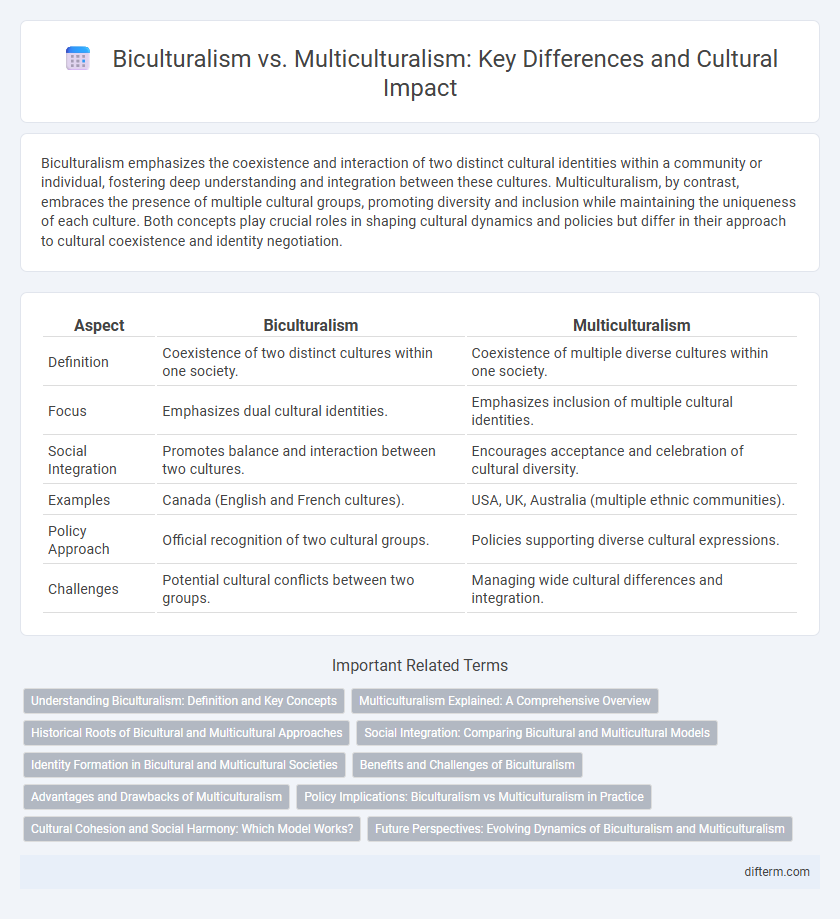Biculturalism emphasizes the coexistence and interaction of two distinct cultural identities within a community or individual, fostering deep understanding and integration between these cultures. Multiculturalism, by contrast, embraces the presence of multiple cultural groups, promoting diversity and inclusion while maintaining the uniqueness of each culture. Both concepts play crucial roles in shaping cultural dynamics and policies but differ in their approach to cultural coexistence and identity negotiation.
Table of Comparison
| Aspect | Biculturalism | Multiculturalism |
|---|---|---|
| Definition | Coexistence of two distinct cultures within one society. | Coexistence of multiple diverse cultures within one society. |
| Focus | Emphasizes dual cultural identities. | Emphasizes inclusion of multiple cultural identities. |
| Social Integration | Promotes balance and interaction between two cultures. | Encourages acceptance and celebration of cultural diversity. |
| Examples | Canada (English and French cultures). | USA, UK, Australia (multiple ethnic communities). |
| Policy Approach | Official recognition of two cultural groups. | Policies supporting diverse cultural expressions. |
| Challenges | Potential cultural conflicts between two groups. | Managing wide cultural differences and integration. |
Understanding Biculturalism: Definition and Key Concepts
Biculturalism refers to the coexistence and functional integration of two distinct cultural identities within an individual or community, emphasizing dual cultural competence and identity negotiation. It involves understanding and navigating the values, beliefs, and social norms of both cultures, often leading to enhanced cognitive flexibility and intercultural communication skills. Key concepts include cultural hybridity, identity balance, and the ability to switch cultural frames depending on social context, distinguishing biculturalism from broader multiculturalism, which encompasses multiple cultural identities simultaneously.
Multiculturalism Explained: A Comprehensive Overview
Multiculturalism refers to the coexistence of diverse cultural groups within a society, emphasizing the equal recognition and respect for different ethnicities, languages, and traditions. It promotes social integration and inclusion by encouraging dialogue and interaction among various cultural communities, fostering mutual understanding and reducing cultural conflicts. Unlike biculturalism, which involves two dominant cultures, multiculturalism embraces multiple cultures simultaneously, supporting a pluralistic and dynamic societal framework.
Historical Roots of Bicultural and Multicultural Approaches
The historical roots of biculturalism trace back to agreements like New Zealand's Treaty of Waitangi in 1840, which established a partnership between Maori and British settlers, emphasizing two distinct cultural identities within one nation. In contrast, multiculturalism emerged primarily in the mid-20th century as post-colonial nations and immigrant societies recognized the presence and value of multiple ethnic groups living together, promoting inclusive policies that acknowledge diverse cultural backgrounds. These differing origins highlight biculturalism's foundation in legally mandated power-sharing between two primary cultures, whereas multiculturalism focuses on the coexistence and respect of many cultural communities within a pluralistic society.
Social Integration: Comparing Bicultural and Multicultural Models
Biculturalism fosters social integration by encouraging individuals to maintain two distinct cultural identities, which can strengthen a cohesive community with shared values and mutual understanding. Multiculturalism promotes social inclusion by recognizing and valuing diverse cultural groups, allowing multiple identities to coexist and interact within society. Both models aim to reduce social fragmentation, but biculturalism often emphasizes deeper cultural bonding, while multiculturalism highlights pluralism and broad cultural representation.
Identity Formation in Bicultural and Multicultural Societies
Identity formation in bicultural societies involves the integration of two distinct cultural frameworks, often resulting in a cohesive yet dual sense of self. In contrast, multicultural societies foster identity construction through the negotiation of multiple cultural influences, promoting fluid and dynamic self-concepts. Research highlights that bicultural individuals frequently develop enhanced cognitive flexibility and cross-cultural competence compared to those in multicultural contexts.
Benefits and Challenges of Biculturalism
Biculturalism fosters deep integration and identity development by enabling individuals to navigate and internalize two distinct cultural frameworks, enhancing cognitive flexibility and social adaptability. Challenges include potential cultural conflicts, identity confusion, and the pressure to balance competing norms and values, which may affect psychological well-being. The benefits of biculturalism often manifest in improved cross-cultural communication, broader worldviews, and increased opportunities in globalized contexts.
Advantages and Drawbacks of Multiculturalism
Multiculturalism fosters social cohesion by promoting inclusivity and mutual respect among diverse ethnic groups, enhancing creativity and innovation through varied perspectives. However, it may also lead to social fragmentation and tensions if integration policies are inadequate, causing challenges in establishing a unified national identity. Balancing cultural preservation with shared societal values remains a critical debate in multicultural policy development.
Policy Implications: Biculturalism vs Multiculturalism in Practice
Biculturalism policies prioritize the recognition and institutional support of two dominant cultural groups, often leading to official bilingualism and dual cultural representation in governance and education systems. Multiculturalism policies emphasize inclusivity of multiple ethnicities and cultures, fostering societal diversity through equal rights, anti-discrimination laws, and multicultural education curricula. Policy implementation of biculturalism can inadvertently marginalize minority groups outside the two main cultures, while multiculturalism aims to promote social cohesion and intercultural dialogue among a broader population spectrum.
Cultural Cohesion and Social Harmony: Which Model Works?
Biculturalism fosters cultural cohesion and social harmony by promoting mutual recognition and respect between two dominant cultural groups, often leading to a shared national identity. In contrast, multiculturalism embraces diversity by encouraging the coexistence of multiple cultural identities, which can enhance social inclusion but sometimes challenge unity. Research indicates that bicultural frameworks may strengthen social bonds in societies with two primary cultures, while multiculturalism better suits pluralistic societies aiming for broad inclusivity.
Future Perspectives: Evolving Dynamics of Biculturalism and Multiculturalism
Biculturalism often emphasizes the coexistence of two dominant cultures, fostering deep integration and identity negotiation, whereas multiculturalism supports the inclusion of multiple cultural identities within society. Future perspectives highlight a dynamic interplay where technological advancements and globalization facilitate hybrid cultural expressions, challenging traditional boundaries between cultures. Emerging models advocate adaptive policies that balance cultural preservation with fluid intercultural exchange, promoting social cohesion in increasingly diverse populations.
biculturalism vs multiculturalism Infographic

 difterm.com
difterm.com